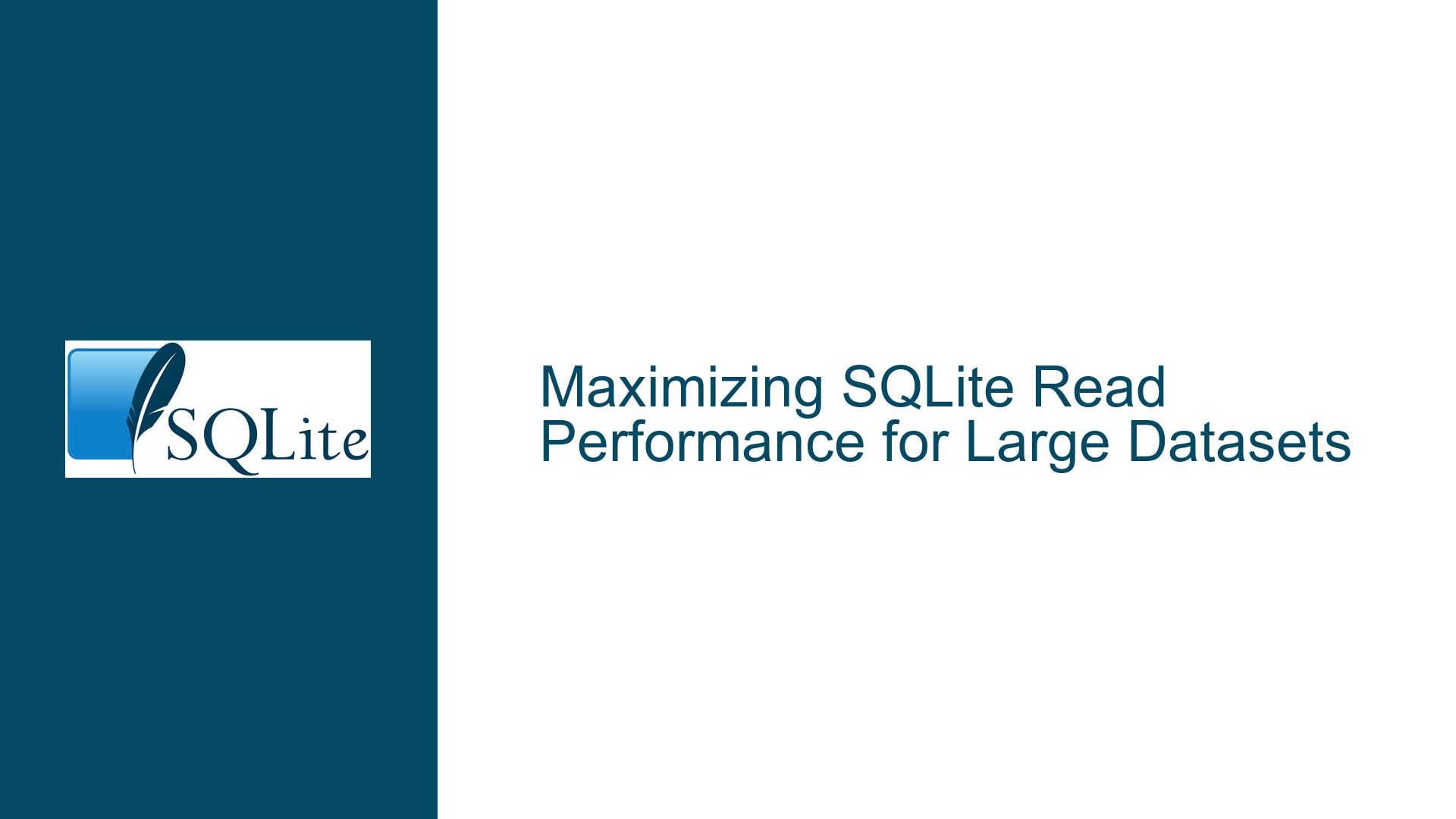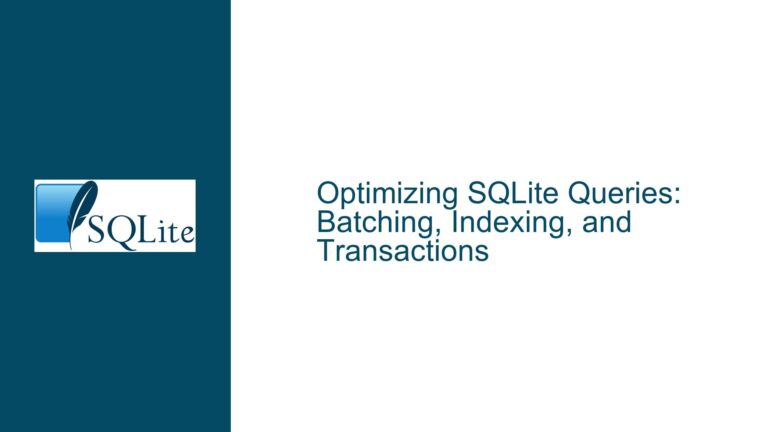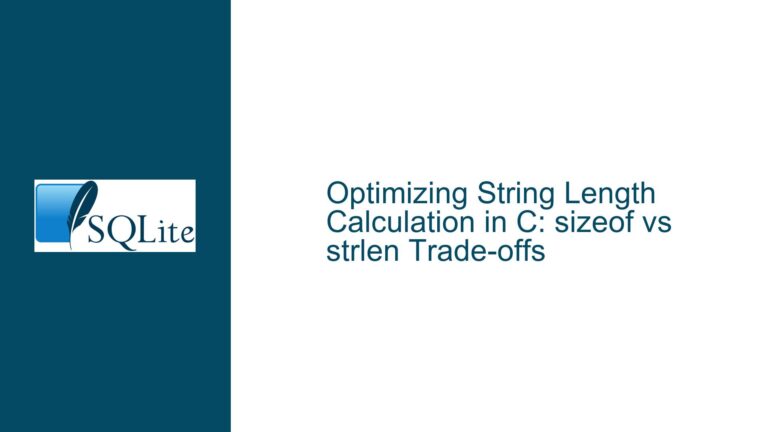Maximizing SQLite Read Performance for Large Datasets
Understanding SQLite Read Performance with Full Table Scans
When dealing with large datasets in SQLite, read performance can become a critical factor, especially when performing full table scans. In this scenario, the user is attempting to read approximately 1 million rows from a table with a simple SELECT * FROM TABLE query. The goal is to optimize this operation to match or exceed the performance of a custom mmap solution that achieves the same task in 500-600ms. Currently, the SQLite implementation takes around 1 second, which, while not drastically slower, leaves room for improvement.
The user has already implemented several optimizations, including compile-time options like -DSQLITE_DEFAULT_MEMSTATUS=0, -DSQLITE_OMIT_DECLTYPE=1, and -DSQLITE_MAX_MMAP_SIZE=2000000000. Additionally, the database is opened in read-only mode with no locking, and specific pragmas such as PRAGMA synchronous=OFF and PRAGMA temp_store = memory are enabled. Despite these efforts, the read performance is still not on par with the custom solution.
To fully understand the issue, it’s essential to consider the nature of SQLite’s architecture. SQLite is a general-purpose database engine designed to handle a wide range of use cases, which inherently introduces some overhead compared to a specialized solution like mmap with fixed-size structs. This overhead includes metadata management, page caching, and other features that ensure data integrity and flexibility. However, with careful tuning, it is possible to narrow the performance gap.
Potential Causes of Suboptimal Read Performance
Several factors could be contributing to the slower read performance in SQLite compared to the custom mmap solution. These factors range from the way SQLite handles data storage and retrieval to the specific configuration and environment in which the database is operating.
One significant factor is the initial cold-start query performance. When a query is executed for the first time, SQLite must load the necessary pages from disk into memory. This process can be slower, especially if the database file is large or fragmented. Subsequent queries may benefit from cached pages, but since the user is only running the query once, this caching effect does not come into play.
Another potential cause is the page size of the database. SQLite uses a default page size of 4096 bytes, which may not be optimal for all use cases. For tables with large BLOBs or many columns, increasing the page size can improve read performance by reducing the number of I/O operations required to retrieve the data. However, this must be done before populating the database, as changing the page size afterward can be complex and time-consuming.
The use of mmap is another area to consider. While the user has set a high DEFAULT_MMAP_SIZE, the effectiveness of mmap depends on how SQLite utilizes it. If the database file is not fully mapped into memory, or if the operating system’s memory management interferes with the mapping, the performance gains from mmap may be limited. Additionally, mmap is more effective when the same data is accessed multiple times, which is not the case here.
The compilation flags used when building SQLite can also impact performance. The user is currently using -O0 for debugging purposes, which disables most optimizations. Switching to -O3 could improve performance by enabling aggressive optimizations, though the actual impact may be limited given the nature of the query.
Finally, the structure of the table itself can influence read performance. The user’s table has 5 columns: 2 text and 3 int64. While this is not an excessively complex schema, the presence of text columns can introduce variability in row size, which may affect how efficiently SQLite can scan the table. Additionally, if the table has undergone many updates or deletions, it may be fragmented, leading to slower read performance.
Detailed Troubleshooting Steps and Solutions
To address the read performance issue, a systematic approach is required. The following steps outline a comprehensive strategy for identifying and resolving the bottlenecks in SQLite’s read performance.
Step 1: Analyze the Query Plan
Before making any changes, it’s crucial to understand how SQLite is executing the query. The EXPLAIN QUERY PLAN statement can provide insights into the steps SQLite is taking to retrieve the data. For a simple SELECT * FROM TABLE query, the output should indicate a full table scan. However, it’s still worth verifying to ensure there are no unexpected operations, such as index scans or temporary table creations, that could be slowing down the query.
Step 2: Optimize Compilation Flags
While the user is currently using -O0 for debugging, switching to -O3 can enable compiler optimizations that may improve performance. It’s recommended to test the query with both -O0 and -O3 to measure the impact. Additionally, other compilation flags, such as -DSQLITE_ENABLE_STAT4, can be considered to enable advanced query planning features that may further optimize the query execution.
Step 3: Adjust Page Size
The default page size of 4096 bytes may not be optimal for the user’s dataset. Increasing the page size can reduce the number of I/O operations required to read the data, potentially improving performance. However, this change must be made before populating the database. To test the impact, the user can create a new database with a larger page size (e.g., 8192 or 16384 bytes) and compare the read performance. It’s important to note that increasing the page size can also affect write performance, so this change should be carefully evaluated.
Step 4: Evaluate mmap Usage
While the user has set a high DEFAULT_MMAP_SIZE, it’s worth verifying how effectively SQLite is utilizing mmap. The PRAGMA mmap_size statement can be used to check the current mmap size and adjust it if necessary. Additionally, monitoring the operating system’s memory usage can provide insights into whether the database file is fully mapped into memory. If mmap is not being fully utilized, the user may need to adjust the mmap size or consider alternative memory management strategies.
Step 5: Defragment the Database
If the table has undergone many updates or deletions, it may be fragmented, leading to slower read performance. Running the VACUUM command can defragment the database and potentially improve read performance. This command rebuilds the database file, ensuring that data is stored contiguously. While the impact may be limited for a single query, it’s still worth testing to see if it provides any performance benefits.
Step 6: Consider Alternative Storage Formats
If the primary goal is to maximize read performance for a specific dataset, it may be worth considering alternative storage formats. For example, storing the data in a columnar format or using a specialized database engine designed for high-speed reads could provide significant performance improvements. However, this approach would require significant changes to the application and may not be feasible in all cases.
Step 7: Profile and Benchmark
Finally, it’s essential to profile and benchmark the changes to measure their impact accurately. Tools like strace can be used to monitor system calls and identify any bottlenecks in the I/O operations. Additionally, benchmarking the query with different configurations can help identify the most effective optimizations. It’s important to test each change individually to isolate its impact and avoid introducing new bottlenecks.
Conclusion
Optimizing SQLite read performance for large datasets requires a thorough understanding of the database’s architecture and the specific use case. By systematically analyzing the query plan, adjusting compilation flags, optimizing page size, evaluating mmap usage, defragmenting the database, and considering alternative storage formats, it is possible to narrow the performance gap between SQLite and custom solutions like mmap. However, it’s important to recognize that SQLite is a general-purpose database engine, and some overhead is inherent in its design. In cases where read performance is critical, a specialized solution may be necessary to achieve the desired results.






